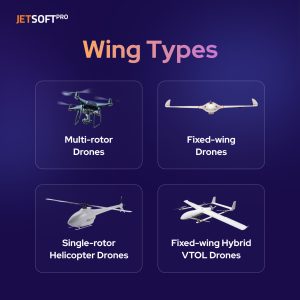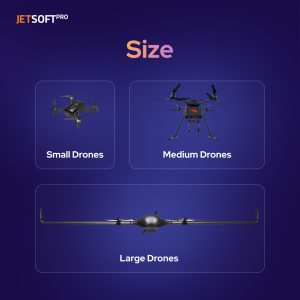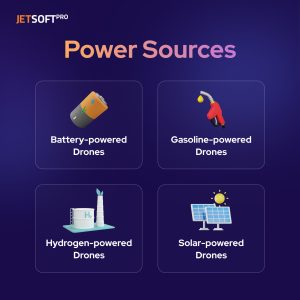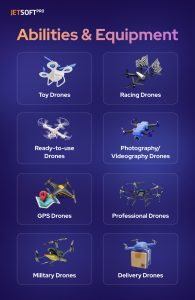The use of unmanned aerial vehicles or drones has a fairly long history, starting in the 19th century. The first drone market served military purposes, of course. Before you integrate drones into your business, let’s go deeper into the market.
Commercial drone usage mainly began after the year 2000. With the emergence of more affordable technologies and reduced manufacturing costs, drones became accessible to a wide range of consumers, and it became easier to integrate drones into your business. The first commercially available drones for recreation emerged in the early 2000s. Over time and with technological advancements, drones started being utilized across various industries such as agriculture, architecture, tourism, medicine, and many others.
Today’s drones are versatile tools widely employed for both commercial and recreational purposes. Their applications span areas such as aerial photography, cargo delivery, environmental monitoring, search and rescue, construction, and much more.
Let’s figure out how to choose a drone for your business and how to determine if it’s a good idea.
What does the drone market look like today?
Currently, there are thousands of drones to integrate into your business on the market, with prices ranging from tens to tens and hundreds of thousands of dollars, and here is the complete typology of our small helpers.
Integrate drones into your business based on Wing Types
- Multi-rotor Drones:
- Advantages: Easy to control, vertical takeoff, lower price.
- Disadvantages: Limited flight time, small payload capacity.
- Uses: Aerial photography, inspection, agriculture.
- Fixed-wing Drones:
- Advantages: Longer flight time, greater stability.
- Disadvantages: Higher cost, complex landing.
- Uses: Mapping, inspection, agriculture.
- Single-rotor Helicopter Drones:
- Advantages: Vertical takeoff, heavier payload.
- Disadvantages: Complexity, high cost.
- Uses: LiDAR scanning.
- Fixed-wing Hybrid VTOL Drones:
- Advantages: VTOL, long endurance.
- Disadvantages: High cost, complex control.
- Uses: Mapping, inspection, rescue.
- Multi-rotor Drones:
Drones based on Size
- Small Drones: For reconnaissance, indoor inspections.
- Medium Drones: Professional applications, aerial photography.
- Large Drones: Mainly for military and large-scale projects.
Drones based on Payload Capacity
- Lightweight Drones: For recreational and light applications.
- Medium Drones: Suitable for professional tasks and photography.
- Heavy-lift Drones: Used for military and heavy cargo.
Drones based on Power Sources
- Battery-powered Drones: Lightweight but short lifespan.
- Gasoline-powered Drones: Longer flight time but high cost.
- Hydrogen-powered Drones: Environmentally friendly but currently inefficient.
- Solar-powered Drones: Reduce operating costs but limited flight time without sunlight.
Drones based on Abilities & Equipment
- Toy Drones: For entertainment and beginners.
- Photography/Videography Drones: Equipped with cameras for professional imaging.
- Racing Drones: Used in FPV racing with high-speed maneuverability.
- Ready-to-use Drones: Assembly kits for hobbyists.
- GPS Drones: Controlled by satellites for precise navigation.
- Professional Drones: Equipped for various aerial services.
- Military Drones: For reconnaissance and combat.
- Delivery Drones: Future potential for package delivery.
Read: Top-10 ways to use drones and what software do they need
Questions before you integrate drones into your business
When planning to integrate drones into your business or develop a new drone, you need to answer several key questions that will determine the technologies you will work with:
- How far should my drone fly?
- How often will I charge it?
- What should be the flight cost?
- How much weight can it carry?
- Under what conditions will it fly?
- What technical capabilities should my drone have?
- What size should the drone be?
Read: Drones and their software – future of the world
I decided to integrate drones into my business. How it works?
For example, you own a pizzeria and want to deliver pizza around your area using drones.
Here are the initial parameters of your business process:
The pizza box measures from 12 to 16 inches on any side (square) and weighs up to 2 kg. The box should not tip over. The pizza must be delivered within a distance of up to 12 miles in a maximum of 20 minutes. The drone delivery will deliver 20 pizzas a day and land on the customer’s porch. It is reasonable for it to spend no more than $10 on delivery. At the same time, we expect to receive +500% of pizza orders thanks to drone delivery advertising.
So, based on this data, we need a drone no larger than the pizza box with vertical takeoff and landing, high precision, capable of flying 12 miles to the customer + 12 miles back multiplied by 20 times = 480 miles per day with one charge or refueling at night. It should lift up to 10 kg (usually no more than 5 pizzas are ordered). It should be stable (without sudden movements) and controlled by a program, not a person. Additionally, it should have a mechanism for detaching the pizza box and photo fixation to successfully integrate drones into your business process.
Based on these parameters, you choose from existing technologies and after calculations understand that one flight costs $30, not $10 as planned, and worse, not $15 like a courier. On the other hand, you expect to attract five times more orders, which will allow you to save on ingredient purchases and offset the increased delivery cost without raising the price of pizza.
Discovery before you integrate drones into your business
Before implementing innovations in business, it makes sense to go through a discovery stage to obtain detailed calculations and an understanding of the effectiveness of the changes. For example, it’s worthwhile to create a virtual prototype first and then, if everything goes well, a real drone prototype with the necessary characteristics and test it in field conditions. JetSoftPro would be happy to become your drone partner on the path to digitizing your business. Contact us today.






